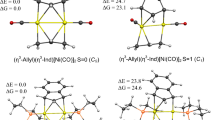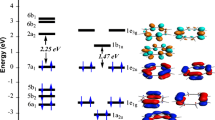Abstract
The nature of the chemical metal–metal bond in M2(CO)10 (M = Mn, Re, Tc) dinuclear decacarbonyls complexes was investigated for the first time using the natural orbital chemical valence (NOCV) approach combined with the extended transition state (ETS) for energy decomposition analysis (EDA). The optimized geometries carried out at different levels of theory BP86, BLYP, BLYPD and BP86D, showed that the latter method, i.e., BP86D, led to the best agreement with X-ray experimental measurements. The BP86D/TZP results revealed that the computed covalent contribution to the metal–metal bond are 60.5%, 54.1% and 52.0% for Mn–Mn, Re–Re and Tc–Tc, respectively. The computed total interaction energies resulting from attractive terms (ΔE orb and ΔE eles), correspond well to experimental predictions, based on bond lengths and energy interaction analysis for the studied complexes.



Similar content being viewed by others
References
Dahl LF, Ishishi E, Rundle RE (1957) Polynuclear metal carbonyls. I. Structures of Mn2(CO)10 and Re2(CO)10. J Chem Phys 26:1750–1751. https://doi.org/10.1063/1.1743615
Wallach D (1962) Unit cell and space group of technetium carbonyl, Tc2(CO)10. Acta Crystallogr 15:1058. https://doi.org/10.1107/S0365110X62002789
Nguyen T, Sutton AD, Brynda M et al (2005) Synthesis of a stable compound with fivefold bonding between two chromium(I) centers. Science 310:844–847. https://doi.org/10.1126/science.1116789
Hsu C-W, Yu J-SK, Yen C-H et al (2008) Quintuply-bonded Dichromium(I) complexes featuring metal–metal bond lengths of 1.74 Å. Angew Chem 120:10081–10084. https://doi.org/10.1002/ange.200803859
Kreisel KA, Yap GPA, Dmitrenko O et al (2007) The shortest metal−metal bond yet: molecular and electronic structure of a dinuclear chromium diazadiene complex. J Am Chem Soc 129:14162–14163. https://doi.org/10.1021/ja076356t
Wagner FR, Noor A, Kempe R (2009) Ultrashort metal–metal distances and extreme bond orders. Nat Chem 1:529–536. https://doi.org/10.1038/nchem.359
Ghoulami A, Ashrafi AR (2008) Symmetry of dimanganese decacarbonyl with D4d point group. Indian J Chem A 47:225
Li WK, Zhou GD, Mak T (2008) Metal–metal bonds and transition-metal clusters. In: Li WK, Zhou GD, Mak T (eds) Advanced structural inorganic chemistry. Oxford University Press, Oxford.
Georgiev VP, Mohan PJ, DeBrincat D, McGrady JE (2013). Coord Chem Rev 257:290
Doyle MP, Duffy R, Ratnikov M, Zhou L (2010). Chem Rev 110:704
Davies HML, Denton JR (2009). Chem Soc Rev 38:3061
Kampa M, Pandelia ME, Lubitz W, van Gastel M, Neese F (2013). J Am Chem Soc 135:3915
Missner K, Korol'kov DV (1972) Electronic structure of the binuclear carbonyls Mn2(CO)10, Tc2(CO)10, and Re2(CO)10. J Struct Chem 13:639–647. https://doi.org/10.1007/bf00739507
Cotton FA, Murillo CA, Walton RA (2005) Multiple bonds between metal atoms. Springer, New York
Liddle ST (2015) Molecular metal-metal bonds: compounds, synthesis, properties, 1st edn. Wiley-VCH, Weinheim
Schultz NE, Zhao Y, Truhlar DG (2005) Density functionals for inorganometallic and organometallic chemistry. J Phys Chem A 109:11127–11143. https://doi.org/10.1021/jp0539223
Cukrowski I, de Lange JH, Mitoraj M (2014) Physical nature of interactions in ZnII complexes with 2,2′-Bipyridyl: quantum theory of atoms in molecules (QTAIM), interacting quantum atoms (IQA), noncovalent interactions (NCI), and extended transition state coupled with natural orbitals for chemical valence (ETS-NOCV) comparative studies. J Phys Chem A 118:623–637. https://doi.org/10.1021/jp410744x
Bader RF (1990) Atoms in molecules: a quantum theory, vol 22, international series of monographs on chemistry. Oxford Science, Oxford
Bader RFW, MacDougall PJ, Lau CDH (1984) Bonded and nonbonded charge concentrations and their relation to molecular geometry and reactivity. J Am Chem Soc 106:1594–1605. https://doi.org/10.1021/ja00318a009
Bader RFW (1998) A bond path: a universal indicator of bonded interactions. J Phys Chem A 102:7314–7323. https://doi.org/10.1021/jp981794v
Maelen JF, Cabeza JA (2016) A topological analysis of the bonding in [M2(CO)10] and [M3(μ-H)3(CO)12] complexes (M = Mn, Tc, re). Theor Chem Accounts 135:1–11. https://doi.org/10.1007/s00214-016-1821-0
Bianchi R, Gervasio G, Marabello D (2000) Experimental electron density analysis of Mn2(CO)10: metal−metal and metal−Ligand bond characterization. Inorg Chem 39:2360–2366. https://doi.org/10.1021/ic991316e
Blanco MA, Martín Pendás A, Francisco E (2005) Interacting quantum atoms: a correlated energy decomposition scheme based on the quantum theory of atoms in molecules. J Chem Theory Comput 1:1096–1109. https://doi.org/10.1021/ct0501093
Pendás AM, Blanco MA, Francisco E (2007) Chemical fragments in real space: definitions, properties, and energetic decompositions. J Comput Chem 28:161–184. https://doi.org/10.1002/jcc.20469
Francisco E, Martín Pendás A, Blanco MA (2006) A molecular energy decomposition scheme for atoms in molecules. J Chem Theory Comput 2:90–102. https://doi.org/10.1021/ct0502209
Gillet N, Chaudret R, Contreras-García J et al (2012) Coupling quantum interpretative techniques: another look at chemical mechanisms in organic reactions. J Chem Theory Comput 8:3993–3997. https://doi.org/10.1021/ct300234g
Contreras-García J, Johnson ER, Keinan S et al (2011) NCIPLOT: a program for plotting noncovalent interaction regions. J Chem Theory Comput 7:625–632. https://doi.org/10.1021/ct100641a
Johnson ER, Keinan S, Mori-Sánchez P et al (2010) Revealing noncovalent interactions. J Am Chem Soc 132:6498–6506. https://doi.org/10.1021/ja100936w
Ziegler T, Rauk A (1977) On the calculation of bonding energies by the Hartree-Fock Slater method. Theor Chim Acta 46:1–10. https://doi.org/10.1007/bf00551648
Mitoraj MP, Michalak A, Ziegler T (2009) A combined charge and energy decomposition scheme for bond analysis. J Chem Theory Comput 5:962–975. https://doi.org/10.1021/ct800503d
Mitoraj M, Michalak A (2007) Natural orbitals for chemical valence as descriptors of chemical bonding in transition metal complexes. J Mol Model 13:347–355. https://doi.org/10.1007/s00894-006-0149-4
Mitoraj MP, Parafiniuk M, Srebro M et al (2011) Applications of the ETS-NOCV method in descriptions of chemical reactions. J Mol Model 17:2337–2352. https://doi.org/10.1007/s00894-011-1023-6
Mitoraj MP, Michalak A, Ziegler T (2009) On the nature of the Agostic bond between metal Centers and β-hydrogen atoms in alkyl complexes. An analysis based on the extended transition state method and the natural Orbitals for chemical valence scheme (ETS-NOCV). Organometallics 28:3727–3733. https://doi.org/10.1021/om900203m
Mitoraj MP, Michalak A (2012) Theoretical description of halogen bonding—an insight based on the natural orbitals for chemical valence combined with the extended-transition-state method (ETS-NOCV). J Mol Model 19:4681–4688. https://doi.org/10.1007/s00894-012-1474-4
Dyduch K, Mitoraj MP, Michalak A (2012) ETS-NOCV description of σ-hole bonding. J Mol Model 19:2747–2758. https://doi.org/10.1007/s00894-012-1591-0
Kan Y-H (2009) Covalent or not? Energy decomposition analysis of metal–metal bonding in alkaline-earth dimetallocene complexes. J Mol Struct THEOCHEM 894:88–92. https://doi.org/10.1016/j.theochem.2008.10.004
Pandey KK (2007) Structure and energy decomposition analysis of metal–metal bonding in [PhM–MPh] and [ClM–MCl] (M = Zn, Cd, hg). J Mol Struct THEOCHEM 823:59–64. https://doi.org/10.1016/j.theochem.2007.08.013
Pandey KK (2007) Energy analysis of metal–metal bonding in [RM–MR] (M = Zn, Cd, hg; R = CH3, SiH3, GeH3, C5H5, C5Me5). J Organomet Chem 692:1058–1063. https://doi.org/10.1016/j.jorganchem.2006.10.067
Kan Y (2007) The nature of metal–metal bond of the dimetallocene complexes [M2(η5-C5R5)2] (M = Zn, Cd, hg; R = H, me): an energy decomposition analysis. J Mol Struct THEOCHEM 805:127–132. https://doi.org/10.1016/j.theochem.2006.11.007
Mitoraj M, Michalak A (2007) Donor–acceptor properties of Ligands from the natural orbitals for chemical valence. Organometallics 26:6576–6580. https://doi.org/10.1021/om700754n
Mitoraj M, Michalak A (2008) Applications of natural orbitals for chemical valence in a description of bonding in conjugated molecules. J Mol Model 14:681–687. https://doi.org/10.1007/s00894-008-0276-1
Mitoraj MP, Kurczab R, Boczar M et al (2010) Theoretical description of hydrogen bonding in oxalic acid dimer and trimer based on the combined extended-transition-state energy decomposition analysis and natural orbitals for chemical valence (ETS-NOCV). J Mol Model 16:1789–1795. https://doi.org/10.1007/s00894-010-0740-6
Mitoraj MP (2011) Bonding in ammonia borane: an analysis based on the natural orbitals for chemical valence and the extended transition state method (ETS-NOCV). J Phys Chem A 115:14708–14716. https://doi.org/10.1021/jp209712s
ADF2014.07, SCM; Theoretical Chemistry. Vrije University, Amsterdam, The Netherlands. http://www.scm.com
Guerra CF, Snijders JG, te Velde G, Baerends EJ (1998) Towards an order-N DFT method. Theor Chem Accounts 99:391
te Velde G, Bickelhaupt FM, van Gisbergen SJA, Guerra CF, Baerends EJ, Snijders JG, Ziegler T (2001) Chemistry with ADF. J Comput Chem 22:931
Becke AD (1986) Completely numerical calculations on diatomic molecules in the local-density approxi tion. Phys Rev A 33:2786–2788
Becke AD (1988) Density-functional exchange-energy approximation with correct asymptotic behavior. Phys Rev A 38:3098–3100
Grimme S (2006) Semiempirical GGA-type density functional constructed with a long-range dispersion correction. J Comput Chem 27:1787–1799. https://doi.org/10.1002/jcc.20495
te Velde G, Bickelhaupt FM, Baerends EJ, Guerra CF, van Gisbergen SJA, Snijders JG, Ziegler T (2001) Chemistry with ADF. J Comput Chem 22:931–967. https://doi.org/10.1002/jcc.1056
Chang C, Pelissier M, Durand P (1986) Regular 2-component pauli-like effective-hamiltonians in dirac theory. Phys Scr 34:394–404. https://doi.org/10.1088/0031-8949/34/5/007
Van Lenthe E, Baerends EJ (2003) Optimized Slater-type basis sets for the elements 1–118. J Comput Chem 24:1142–1156. https://doi.org/10.1002/jcc.10255
Gorelsky SI (2010) AOMix program for molecular orbital analysis. University of Ottawa, Canada
ADF-GUI, Amsterdam, The Netherlands. http://www.scm.com
Ziegler T, Rauk A (1979) Theoretical-study of the ethylene-metal bond in complexes between cu+, Ag+, au+, pt-0, or pt-2+ and ethylene, based on the hartree-fock-slater transition-state method. Inorg Chem 18:1558–1565. https://doi.org/10.1021/ic50196a034
Nalewajski RF, Formosinho SJ, Varandas AJC, Mrozek J (1994) Quantum mechanical valence study of a bond-breaking–bond-forming process in triatomic systems. Int J Quantum Chem 52:1153–1176. https://doi.org/10.1002/qua.560520504
Nalewajski RF, Mrozek J (1994) Modified valence indices from the two-particle density matrix. Int J Quantum Chem 51:187–200. https://doi.org/10.1002/qua.560510403
Nalewajski RF, Mrozek J (1996) Hartree-Fock difference approach to chemical valence: three-electron indices in UHF approximation. Int J Quantum Chem 57:377–389. https://doi.org/10.1002/(sici)1097-461x
Nalewajski RF, Mrozek J, Mazur G (1996) Quantum chemical valence indices from the one-determinantal difference approach. Can J Chem 74:1121–1130. https://doi.org/10.1139/v96-126
Nalewajski RF, Mrozek J, Michalak A (1997) Two-electron valence indices from the Kohn-Sham orbitals. Int J Quantum Chem 61:589–601. https://doi.org/10.1002/(sici)1097-461x
Michalak A, DeKock RL, Ziegler T (2008) Bond multiplicity in transition-metal complexes: applications of two-electron valence indices. J Phys Chem A 112:7256–7263. https://doi.org/10.1021/jp800139g
Nalewajski RF, Michalak A (1998) Exploring bonding patterns of molecular systems using quantum mechanical bond multiplicities. Pol J Chem 72:1779–1791
Michalak A, Mitoraj M, Ziegler T (2008) Bond orbitals from chemical valence theory. J Phys Chem A 112:1933–1939. https://doi.org/10.1021/jp075460u
Broclawik E, Załucka J, Kozyra P et al (2011) Formaldehyde activation by cu(I) and Ag(I) sites in ZSM-5: ETS-NOCV analysis of charge transfer processes. Catal Today 169:45–51. https://doi.org/10.1016/j.cattod.2010.08.020
Xu B, Li Q-S, Xie Y et al (2008) Binuclear manganese and rhenium carbonyls M2(CO)n (n = 10, 9, 8, 7): comparison of first row and third row transition metal carbonyl structures. Dalton Trans 14:2495–2502. https://doi.org/10.1039/b715211f
Gapotchenko NI, Struchkov YT, Alekseev NV et al (1973) Electron-diffraction investigation of the structure of the dirhenium decacarbonyl molecule in the gas phase. J Struct Chem 14:383–387. doi:https://doi.org/10.1007/bf00746985
Acknowledgments
The authors are grateful to Pr. Agustí Lledós, Pr. Gregori Ujaque, Dr. Manuel A. Ortuno, and all the members of their group for their valuable help during the internship at the Autonomous University of Barcelona, and to Kaouther Boudjemaa for her technical assistance. The financial support of the Mentouri University of Constantine is also acknowledged.
Author information
Authors and Affiliations
Corresponding author
Electronic supplementary material
ESM 1
(DOCX 14 kb)
Rights and permissions
About this article
Cite this article
Menacer, R., May, A., Belkhiri, L. et al. Electronic structure and bonding of the dinuclear metal M2(CO)10 decacarbonyls: applications of natural orbitals for chemical valence. J Mol Model 23, 358 (2017). https://doi.org/10.1007/s00894-017-3523-5
Received:
Accepted:
Published:
DOI: https://doi.org/10.1007/s00894-017-3523-5




